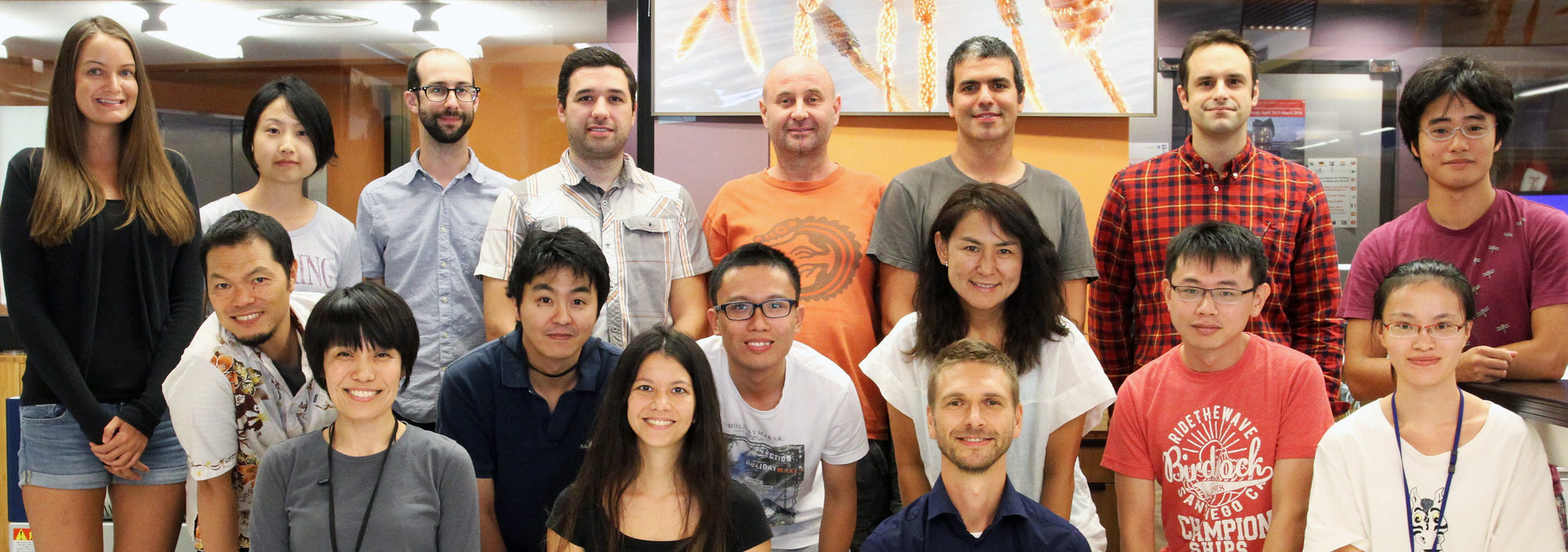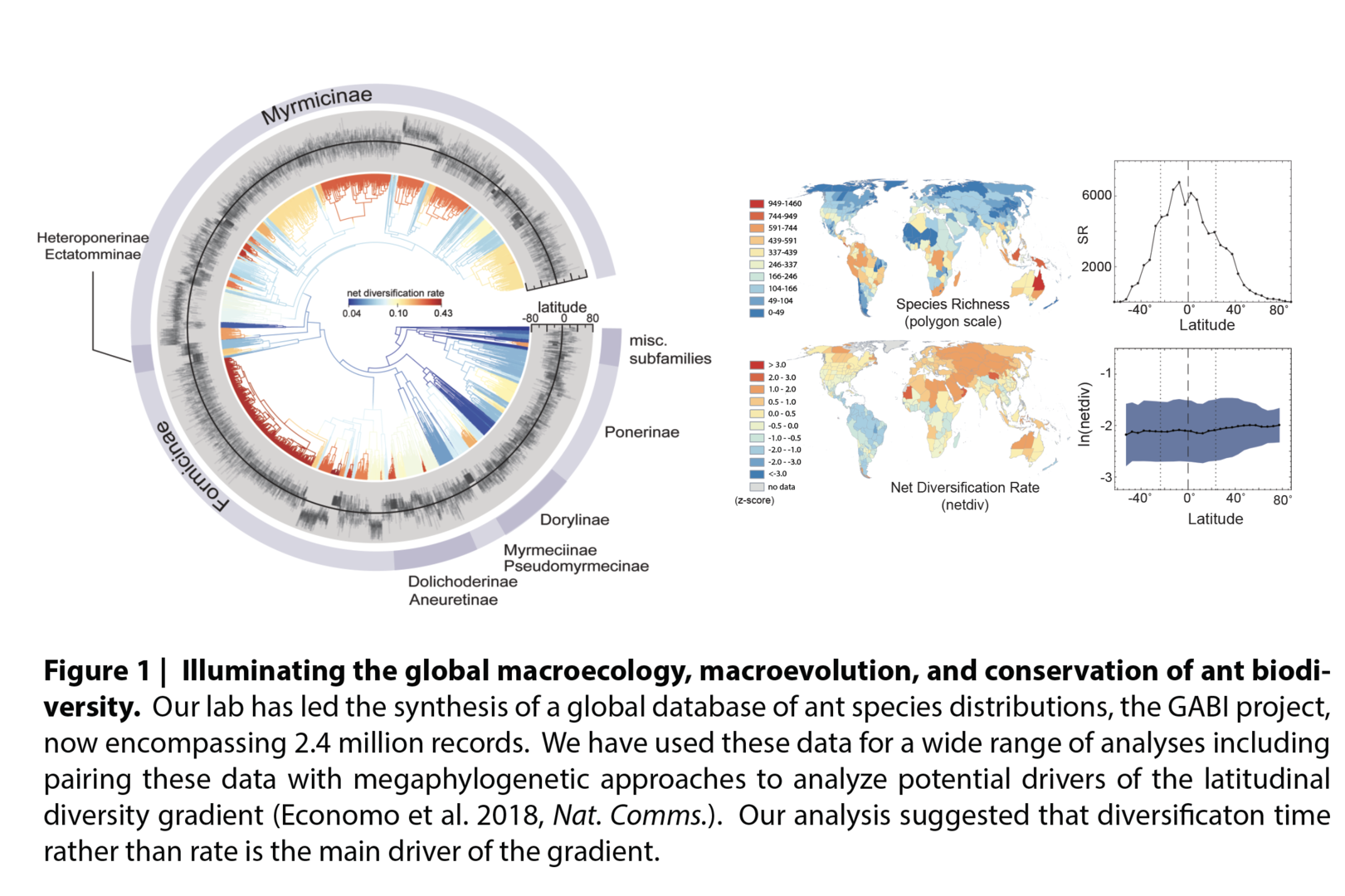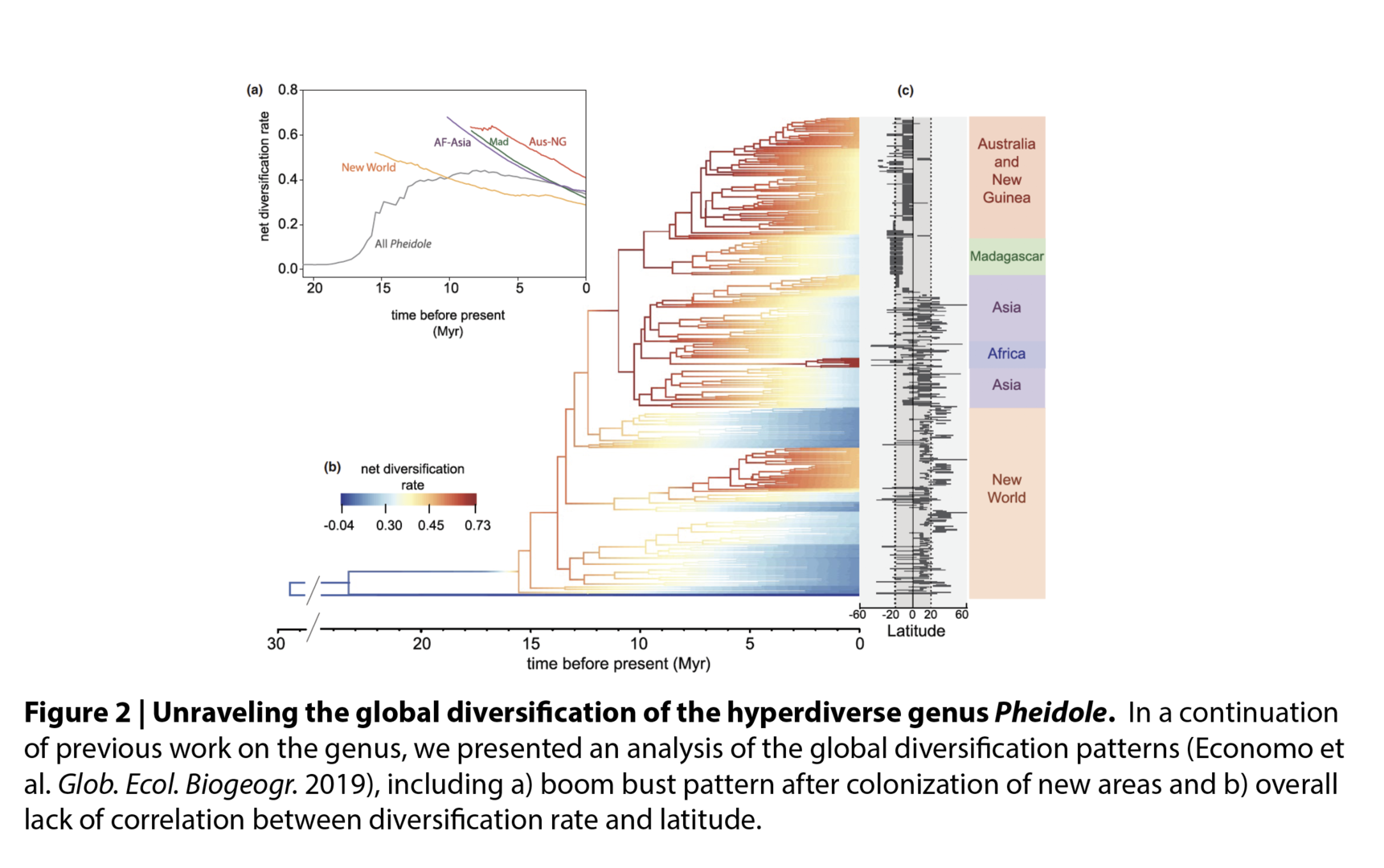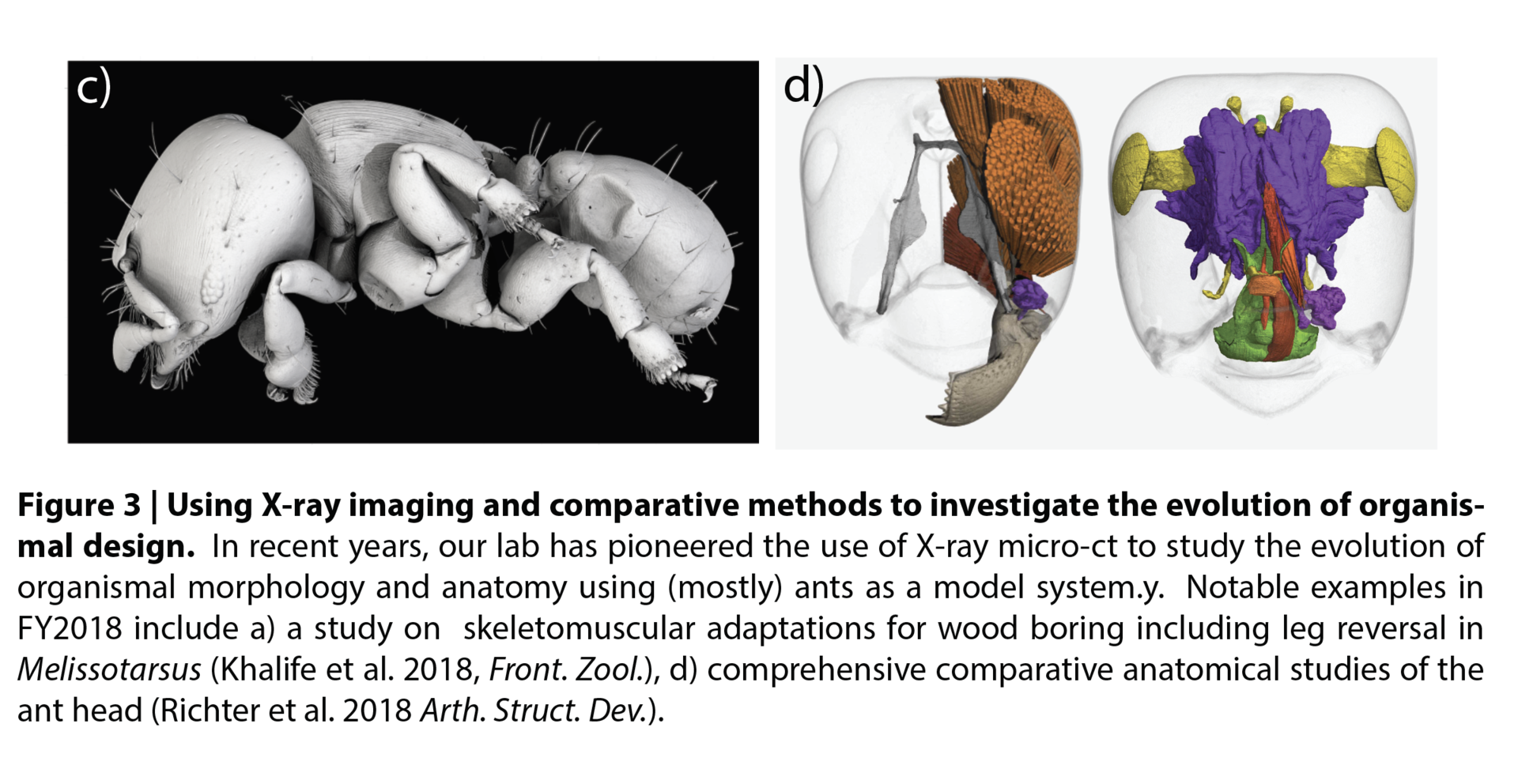FY2018 Annual Report
Biodiversity and Biocomplexity Unit
Assistant Professor Evan Economo

Abstract
Our lab seeks to understand how ecological and evolutionary processes interact to generate and regulate biodiversity across spatiotemporal scales and levels of biological organization. Living systems are diverse from gene sequences to organismal morphology to communities and ecosystems. Our goal as biologists is not just to document and catalogue this diversity, but understand the complex interactions and dynamics that generate and sustain biological variation.
In FY2018, our research concentrated in five areas; our project on the evolution of the hyperdiverse ant radiations, our Global Ant Biodiversity Informatics (GABI) project which focuses on compiling analyzing global distributions of past and present ant biodiversity, and systematics, ecology, and evolution of Indo-Pacific ant faunas, the OKEON Churamori Project, and analyzing the evolution of organismal design using x-ray imaging.
1. Staff
- Dr. Francisco Hita Garcia, Staff Scientist
- Dr. Masashi Yoshimura, Staff Scientist
- Dr. Nicholas Friedman, Postdoctoral scholar
- Dr. Georg Fischer, Postdoctoral Scholar
- Dr. Susan Kennedy, Postdoctoral Scholar
- Dr. Nao Takashina, JSPS Postdoctoral Fellow
- Dr. Mayuko Suwabe, Research Technician
- Fumika Azuma, Research Technician
- Takuma Yoshida, Research Technician
- Kenneth Dudley, Research Technician
- Masako Ogasawara, Research Technician
- Chisa Oshiro, Research Unit Administrator
- Yuka Suzuki, Graduate Student
- Yazmin Zurita-Gutierrez, Graduate Student
- Julian Katzke, Graduate Student
- Evropi Toulkeridou, Graduate Student
- Izumi Maehira, Temp staff
- Yasutaka Tamaki, Temp staff
- Shinji Iriyama, Temp staff
- Toshihiro Kinjo, Temp staff
- Ayumi Inoguchi, Temp staff
- Shoko Suzuki, Temp staff
2. Activities and Findings
2.1 Global Ant Biodiversity Informatics (GABI) Project
Our understanding of large-scale biodiversity patterns has recently increased dramatically, but available information is strongly biased towards a few groups of vertebrates and plants. Biodiversity patterns in invertebrates, such as insects, are poorly documented despite representing the large majority of species. To address this gap in our knowledge, the Global Ant Biodiversity Informatics (GABI) project has compiled over 250 years of ant research into a single database providing distribution information for all ant species. These data can be used to support all kinds of research and are being used somehow in most of our ant projects. However, the two main analyses we are working on with these data are analyzing global ant diversification patterns across the globe, and a comparison of how global patterns of ant endemism compare with vertebrate groups.
In FY2018, we have continued to maintain and build the GABI dataset so it can be used for different research purposes, and reached several important milestones. Notably, we published a first polygon level version of the dataset and analyzed the origins of the latitudinal gradient on a global scale (Economo et al. 2018, Nature Communications, Fig. 1), and in the genus Pheidole (Economo et al. 2019, Glob. Ecol. Biogeogr.) We also continued our collaborative work on large-scale cross-taxon efforts to map and understand the spread of alien species around the world, with new studies on alien species on islands (Moser et al. 2018, PNAS, Economo et al. 2018, J. Biogeogr.), and contributed to a perspective piece on tropical ecosystems (Barlow et al. 2018, Nature).

2.2 Evolution, Ecology, and Systematics of Hyperdiverse Ant Radiations
Over evolutionary time lineages evolve in and out of ecological niches, evolve through morphological spaces, and ranges expand and contract in geographic space. These transitions may not be independent, some phenotypes may be better suited to certain ecological habitats, some habitats may promote dispersal and colonization, and colonization of new geographic areas may lead to ecological niche shifts. These ideas form the basis for integrative hypotheses like the taxon cycle. In collaboration with the Knowles lab at the U. of Michigan, we have a funded project to examine the joint dynamics of these transitions in the famously diverse ant genus Pheidole, which contains over 1000 described species and is the dominant ant genus in many tropical ecosystems worldwide. We reconstructed a new global phylogeny of the genus and used it to analyze its macroevolution and macroecology, with particular attention to the Old World. We also recently initiated new projects on other hyperdiverse ant radiations, namely the genera Strumigenys (in collaboration with Doug Booher) and Tetramorium (led by Staff Scientist Paco Hita Garcia). Strumigenys is a leaf-litter predator that has evolved a complex trap-jaw mechanism, and we are examining the evolution of this trait in time and space. In Tetramorium, we are analyzing biogeography, morphological evolution, and transitions between ecological generalism and specialism. Specimen work and RAD-sequencing for phylogenomics reconstruction is ongoing for these groups.
In FY2018, we made progress on all of the projects above, with phylogenies available for Strumigenys, Tetramorium, and Pheidole. We published a new global phylogeny of Pheidole (Economo et al. 2019, Glob. Ecol. Biogeogr., Fig 2), and gave a number of talks on diversification of these genera.

2.3 Biodiversity, Biogeography, and Evolutionary Ecology of Indo-Pacific Biodiversity
Ants are among the most ubiquitous and ecologically dominant animal groups. Over millions of years, ant biodiversity has evolved and dispersed from Asia and Australia through the vast network of Pacific islands. More recently, humans have unintentionally introduced many species from around the globe into the Pacific. We seek to understand the historical and contemporary processes that regulate ant biodiversity over time.
In FY2018, we continued a series of published works on the Indo-Pacific ant faunas, including a new paper on ant communities in the Andamans (Agavekar et al. 2018, Ins. Cons. Div.) new species in China (Staab et al. 2018, ZooKeys). We continued work on molecular approaches to biogeography in the Pacific with several manuscripts forthcoming. We also published a paper on Indo-Pacific coral evolution (Mao et al. 2018, Current Biology), and a paper on biodiversity theory (Takashina et al. 2019, J. Theor. Biol.)
2.4 OKEON Churamori Project
In collaboration with the Mikheyev unit here at OIST, in FY2013 we initiated a major initiative called the OKEON Chura-Mori Project (OKEON stands for Okinawa Environmental Observation Network). The goal is to develop an observation system to measure and monitor the environment of Okinawa, in collaboration with the people of Okinawa. The primary scientific goal is to develop long-term space-time data series from sites across the island.
As of FY2018, the field network is now fully operational and collecting data every 2 weeks. We have also been broadening the activities and partners, we now have over 140 partners in the project. See the OKEON website for more on our activities. We began analyzing ant community data and formed a new Pacific-wide collaboration with colleagues in the US (Rosemary Gillespie, George Roderick, Haldre Rogers) and Germany (Henrik Krehenwinkel) to deploy metabarcoding methods in Okinawa and across the Pacific islands.
Another major development was the increasing interest in fire ant surveillance in Japan, with the arrival of the species to many ports across the country. We continued our OPG-funded project to use the OKEON system to monitor for fire ants and other introduced species. We are working with community programs to use social network to identify fire ants, and use trapping methods at sensitive areas to identify the ant after it arrives.
2.5 Analyzing evolution of organismal design with X-ray micro-CT
Since the earliest biological studies, description and quantification of biological structures has been a basic goal of biology as well as a first step toward deeper understanding of ecological and evolutionary processes. In Entomology, the primary imaging tools have traditionally been optical microscopy and SEM, which are essential for certain tasks and allow us to see complex structures well. But these are limited in our ability to quantitatively characterize complex shapes, surfaces, and textures. X-Ray CT has the potential to complement existing tools by providing a digital 3D image of the interior and exterior of the organism. These images can be manipulated, dissected, measured, and quantified. We have been developing imaging and post-processing techniques to better quantify the functional morphology of ants, including both external and internal structures. This provides a basis for a research program analyzing the evolution of organismal design.
In FY2018 we continued a series of systematic papers using micro-CT (Staab et al. 2018, ZooKeys), and published papers on anatomy of ants (Richter et al. 2018, Arth. Struct. Dev., Fig 3), the remarkable biomechanical adaptations of Melissotarsus (Khalife et al. 2018, Front. Zool., Fig 3), and gave a number of presentations. We continued work on analyzing 3D evolution of Pheidole, Tetramorium, Strumigenys, and other groups. We also published a paper on the evolution of fish brains (Iglesias et al. 2018, JEB).

3. Publications
3.1 Journal Articles
1. Darwell, C., Ayyampalayam, S., Leebens-Mack, J., Smith, C.I., Segraves, K.A., Althoff, D.M. Phylogenomic reconstruction of transcriptome data confirms the basal position of Prodoxidae moths within the order Lepidoptera. Arthropod Systematics & Phylogeny (2018).
2. Darwell, C., Segar, S., Cook, J.M. Conserved community structure and simultaneous divergence events in the fig wasps associated with Ficus benjamina in Australia and China. BMC Ecology, https://doi.org/10.1186/s12898-018-0167-y (2018).
3. Economo, E.P., Narula, N., Friedman, N.R., Weiser, M.D., Guénard, B. Macroecology and macroevolution of the latitudinal diversity gradient in ants. Nature Communications, http://dx.doi.org/10.1038/s41467-018-04218-4 (2018).
4. Iglesias, T., Dornburg, A., Warren, D., Wainwright, P., Schmitz, L., Economo, E.P. Eyes Wide Shut: the impact of dim‐light vision on neural investment in marine teleosts. Journal of Evolutionary Biology, https://doi.org/10.1111/jeb.13299 (2018).
5. Ross, S.R.P.-J., Hita Garcia, F., Fischer, G. & Peters, M.K. Selective logging intensity in an East African rain forest predicts reductions in ant diversity. Biotropica, https://doi.org/10.1111/btp.12569 (2018).
6. Roth, R.E., Young, S., Nestel,C., Sack, C., Davidson, B., Janicki, J., Knoppke-Wetzel, V., Ma, F., Mead, R., Rose, C. & Zhang, G. Global Landscapes: Teaching Globalization through Responsive Mobile Map Design. The Professional Geographer, https://doi.org/10.1080/00330124.2017.1416297 (2018).
7. Staab, M., Hita Garcia, F., Liu, C., Xu, Z.H., Economo, E.P. Systematics of the ant genus Proceratium Roger (Hymenoptera, Formicidae, Proceratiinae) in China – with descriptions of three new species based on micro-CT enhanced next-generation-morphology. ZooKeys, http://dx.doi.org/10.3897/zookeys.770.24908 (2018).
8. Takashina, N., Kusumoto, B., Beger, M., Rathnayake, S., Possingham, H.P. Spatially explicit approach to estimation of total population abundance in field surveys. Journal of Theoretical Biology, https://doi.org/10.1016/j.jtbi.2018.05.013 (2018).
9. Agavekar, G., Agashe, D., Economo, E.P. Dimensions of ant diversity on a small tropical island. Insect Conservation and Diversity, https://doi.org/10.1111/icad.12326 (2018).
10. Barlow, J., Franca, F., Gardner, T.A., Hicks, C., Lennox, G., Berenguer, E., Castello, L., Economo, E.P., Ferreira, J., Guénard, B., Leal, C.G., Isaac, V., Lees, A., Parr, C., Wilson, S., Young, P., Graham, N. The future of hyperdiverse tropical ecosystems. Nature, https://doi.org/10.1038/s41586-018-0301-1 (2018).
11. Khalife, A., Keller, R.A., Billen, J., Hita Garcia, F., Economo, E.P., & Peeters, C. Skeletomuscular adaptations of head and legs of Melissotarsus ants for tunnelling through living wood. Frontiers in Zoology, https://doi.org/10.1186/s12983-018-0277-6 (2018).
12. Mbanyana, N., Hita Garcia, F., Robertson, H.G. & Leroux, J.C. A taxonomic revision of seed harvester ants of the Tetramorium solidum group (Hymenoptera: Formicidae) in southern Africa. European Journal of Taxonomy (2018).
13. Moser, D., Lenzer, B., Weigelt, P., Dawson, W., Kreft, H., Pergl, J., Pyšek, P., van Kleunen, M., Winter, M., Capinha, C., Cassey, P., Dullinger, S., Economo, E.P., García-Díaz, P., Guénard, B., Hofhansl, F., Mang, T., Seebens, H., Essl, F. Remoteness promotes biological invasions on islands worldwide. PNAS, https://doi.org/10.1073/pnas.1804179115 (2018).
14. Economo, E.P., Huang, J.P., Fischer, G., Sarnat, E.M., Janda, M., Narula, N., Guénard, B., Longino, J., Knowles, L.L. Evolution of the latitudinal diversity gradient in the hyperdiverse ant genus Pheidole. Global Ecology and Biogeography, https://doi.org/10.1111/geb.12867 (2019).
15. Mao, Y., Economo, E.P., Satoh, N. The Roles of Introgression and Climate Change in theRise to Dominance of Acropora Corals. Current Biology, https://doi.org/10.1016/j.cub.2018.08.061 (2018).
16. Smith, A.B.,Godsoe, W., Rodríguez-Sánchez, F., Wang, H.H., Warren, D. Niche Estimation Above and Below the Species Level. Trends in Ecology & Evolution, https://doi.org/10.1016/j.tree.2018.10.012 (2019).
17. Takashina, N., Kusumoto, B., Kubota,Y., Economo, E.P. A geometric approach to scaling individual distributions to macroecological patterns. Journal of Theoretical Biology, https://doi.org/10.1016/j.jtbi.2018.10.030 (2019).
18. Agavekar, G., Agashe, D., Economo, E. P. Dimensions of ant diversity on a small tropical island. Insect Conservation and Diversity, https://doi.org/10.1111/icad.12326 (2019).
19. Hashimoto, Y., Yoshimura, M., Huang, R-N. Wasabi versus red imported fire ants: preliminary test of repellency of microencapsulated allyl isothiocyanate against Solenopsis invicta (Hymenoptera: Formicidae) using bait traps in Taiwan. Applied Entomology and Zoology, https://doi.org/10.1007/s13355-019-00613-5 (2019).
20. Richter, A., Keller, R. A., Rosumekd, F. B., Economo, E. P., Hita Garcia, F., Beutel, R. G. The cephalic anatomy of workers of the ant species Wasmannia affinis (Formicidae, Hymenoptera, Insecta) and its evolutionary implications. Arthropod Structure & Development, https://doi.org/10.1016/j.asd.2019.02.002 (2019).
21. Yoshimura, M. RIFA - The current crisis and the beginning of a new battle. Chapter 3. Countermeasure strategy to the invasion of RIFA under the collaborations with citizen science. Seibutsu no Kagaku Iden, (2019).
3.2 Oral and Poster Presentations
-
Takashina, N. Geometric approach to understand macroecological patterns in ecosystems, The 65th Annual Meeting of the Ecological Society of Japan, Sapporo, Hokkaido, Japan, March 16 (2018).
-
Ross, Samuel RP-J, Friedman, N. R., Janicki, J., Economo, E. P. Bigger is better: Island size influences trophic group diversity of the Ryūkyūs, The 65th Annual Meeting of the Ecological Society of Japan, Sapporo, Hokkaido, Japan, March 15 (2018).
-
Suzuki, Y. Economo, Evan P. The relationship between dispersal connectivity structure and biodiversity, The 65th Annual Meeting of the Ecological Society of Japan, Sapporo, Hokkaido, Japan, March 15 (2018).
-
Friedman, N. R. Evolution across geographic gradients in a model clade of Australian songbirds, The Ornithological Society of Japan Annual Meeting 2018, Niigata, Niigata Prefecture, Japan, September 15 (2018).
-
Hita Garcia, F. 3D ants and next-generation phenomics: from cybertypes to virtual natural history collections, The 9th Congress of International Society of Hymenopterists in 2018, Matsuyama, Ehime Prefecture, Japan, July 27 (2018).
-
Ross, S. RP-J., Friedman, N. R., Yoshimura, M., Donohue, I., Economo, E. P. Using ecoacoustics to monitor ecological stability along an urbanisation gradient, The 103rd Annual meeting of the Ecological Society of America, New Orleans, Louisiana, U.S.A., August 8 (2018).
-
Hita-Garcia, F., Friedman, N. R., Khalife, A., Economo, E. P. Next-generation phenomics and the renaissance of morphology in ant systematics, 2018 ESA, ESC, and ESBC Joint Annual Meeting (Entomology 2018), Vancouver, British Columbia, Canada, November 13 (2018).
-
Katzke, J., Friedman, N., Hita-Garcia, F., Fischer, G., Blaimer, B., Fisher, B., Economo, E. P. Form follows phylogeny? Insights into Crematogaster ant evolution by combining micro-CT and geometric morphometrics, 2018 ESA, ESC, and ESBC Joint Annual Meeting (Entomology 2018), Vancouver, British Columbia, Canada, November 12 (2018).
-
Ross, S. RP-J., Friedman, N. R., Yoshimura, M., Donohue, I., Economo, E. P. Using ecoacoustics to monitor ecological stability along an urbanisation gradient in Okinawa, Japan, British Ecological Society Annual Meeting 2018, Birmingham, U.K., December 19 (2018).
-
Ross, S. RP-J., Friedman, N. R., Yoshimura, M., Donohue, I., Economo, E. P. Urbanisation erodes ecoacoustic diversity and stability in Okinawa, Japan, 2nd Irish Ecological Association Ecology and Evolution Conference, Galway, Connacht, Ireland, January 12 (2019).
-
Ross, S. RP-J., Friedman, N. R., Janicki, J., Economo, E. P. Extended Island Biogeography theory: multiple dimensions of biodiversity. Frontiers and Horizons in Ecology, Belfast, Northern Ireland, UK, November 1 (2018).
-
Agavekar, G., Agashe, D., Economo, E. P. Regional and local determinants of island community assembly. International Biogeography Society Biennial Meeting Malaga 2019, Malaga, Spain, January 10 (2019).
-
Economo, E. P. Global biodiversity informatics for tracking the spread of introduced ant species. The 66th Annual Meeting of the Ecological Society of Japan, Kobe, Hyogo, Japan, March 17 (2019).
-
Economo, E. P., Liu, C., Darwell, C. T., Friedman, N. R., Fischer, G., Sarnat, E., Mikheyev, A. A phylogenomic and population genomic test of the taxon cycle model of island biogeography. International Biogeography Society Biennial Meeting Malaga 2019, Malaga, Spain, January 9 (2019).
-
Friedman, N. R., Ball, J. R., Kasuga, H., Economo, E. P., Remeš, V. Evolution of a multifunctional trait: shared effects of feeding ecology and thermoregulation on beak morphology, with consequences for song evolution. The 66th Annual Meeting of the Ecological Society of Japan, Kobe, Hyogo, Japan, March 18 (2019).
-
Friedman, N. R., Remeš, V., Economo, E. P. A morphological integration perspective on the evolution of dimorphism among sexes and social insect castes. Society for Integrative and Comparative Biology Annual Meeting, Tampa, Florida, USA, January 6 (2019).
-
Ross, S. RP-J., Friedman, N. R., Yoshimura, M., Donohue, I., Economo, E. P. Temporal Dynamics: Urbanisation degrades Okinawa's biotic soundscape. The 66th Annual Meeting of the Ecological Society of Japan, Kobe, Hyogo, Japan, March 17 (2019).
-
Ross, S. RP-J., Friedman, N. R., Yoshimura, M., Donohue, I., Economo, E. P. Disentangling Ecoacoustic Diversity and Stability. Trinity College Dublin Botany/Zoology Postgraduate Symposium 2019, Dublin, Ireland, February 26 (2019).
-
Suzuki, Y., Ross, S RP-J. Ecological Stability: Spatial and Temporal Dynamics. The 66th Annual Meeting of the Ecological Society of Japan, Kobe, Hyogo, Japan, March 17 (2019).
-
Hashimoto, Y., Yasozima, M., Yoshimura, M., Ogasawara, M., Suwabe, M., Huang, R-N. Wasabi versus Fire ants-Repellent effect of Wasabi against S. invicta & geminate. The 66th Annual Meeting of the Ecological Society of Japan, Kobe, Hyogo, Japan, March 19 (2019).
-
Yoshimura, M. Role of taxonomic studies of Japanese ants for the identification of alien species and the associated citizen-based monitoring system. The 66th Annual Meeting of the Ecological Society of Japan, Kobe, Hyogo, Japan, March 17 (2019).
3.3 Books and other One-Time Publications
1. Friedman, N. R. The Natural Soundscapes of the Ryukyus. Okinawa: Okinawa Municipal Museum (2018).
4. Meetings and Events
4.1 Talks by visitors
1. Dr. Ulf Dieckmann, IIASA, “Complex Adaptive Systems at the Interface of Ecology and Evolution, Statistical Physics, and Social Dynamics” (December 5, 2018)
2. Dr. Masaru Hasegawa, SOKENDAI, “Micro- and macroevolution of fork tails in swallows” (November 16, 2018)
3. Dr. Alex Dornburg, North Carolina Museum of Natural Sciences, "Phylogenomics of Adaptive Radiation in Antarctic Fishes" (October 23, 2018)
4. Prof. Lars Schmitz, W.M. Keck Science Center, "Adaptive Signals in the Evolution of Vertebrate Eyes" (October 23, 2018)
5. Dr. Matt Brandley, New South Wales, "The repeated convergent evolution of correlated life history traits and phenotype in the Izu Island lizard (Plestiodon latiscutatus)" (October 23, 2018)
6. Prof. Akito Kawahara, University of Florida, “Evolution and Diversification of Butterflies and Moths: Anti-Bat Ultrasound Jamming, Acoustic Deflection, and Visual Lures” (October 11, 2018)
7. Eva Kolařova, Palacký University, “Phenology: trees and birds under climate change” (May 17, 2018)
8. Prof. Vladimír Remeš, Palacký University, “Comparative biology of parental behaviour in birds” (May 17, 2018)
9. Dr. Amanda Hund, University of Colorado, “How parasites shape host behavior and evolution: mechanistic experiments to population-level comparisons” (May 11, 2018)
10. Prof. Elizabeth Scordato, California State Polytechnic University, “Processes contributing to population divergence and hybridization: insights from barn and Pacific swallows” (May 11, 2018)



